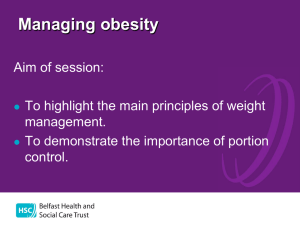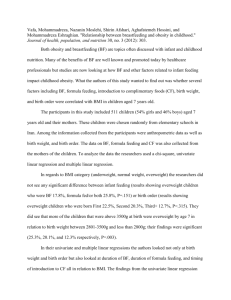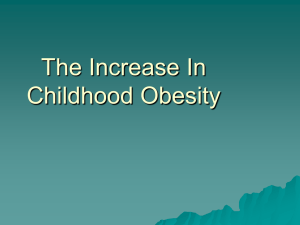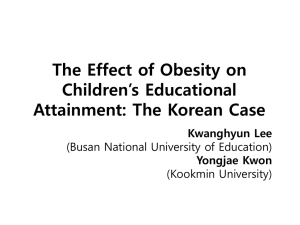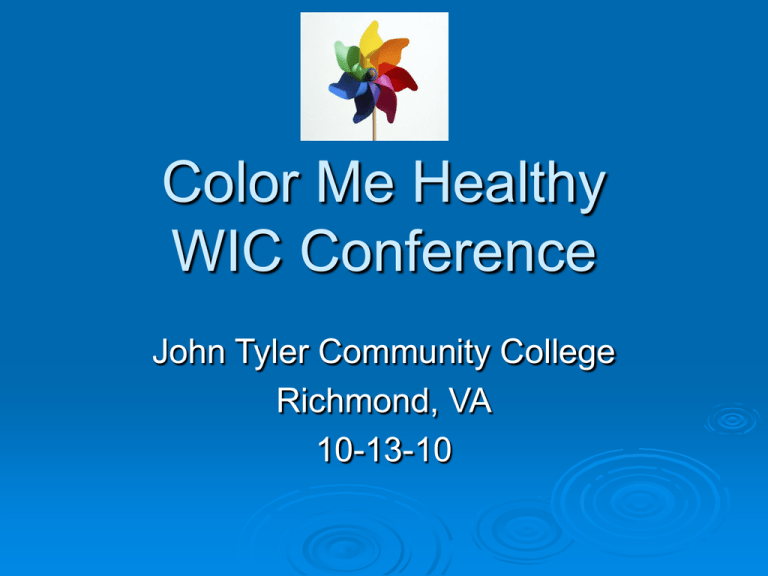
Color Me Healthy
WIC Conference
John Tyler Community College
Richmond, VA
10-13-10
Tipping Point: Childhood
Obesity From Inception,
Conception, and Beyond
John Harrington MD
Associate Professor of Pediatrics
Eastern Virginia Medical School
Director of General Academic Pediatrics
Children’s Hospital of The King’s Daughters
Objectives
Obesity risks before, during, and soon after
pregnancy
Tipping Point Study
Breast versus Bottle
Self Regulation of Oral Feeding
Guidelines for Feeding, Sleeping and Exercise
Environment and Advocating
Conclusions
So who contributes to the
weight of the infant mom or
dad?
No such thing as fat sperm
Mom and Dad
Mom’s
pre-pregnancy BMI is correlated
with child’s BMI at age 3.
Dad’s BMI is less correlated in most
studies
Maternal history of Diabetes increases risk
of ↑ BMI
Maternal history of smoking associated
with obesity in child at age 5
Opposites do not
necessarily attract
Couple’s risk
Overweight/Obese
female likely to marry
or procreate with Overweight/obese male
Recent study shows overweight/obese
girls more likely to start having sex earlier
and to get pregnant.
Eating habits inherited, but can be
modified by geography (American couple
in East Asia)
Obesity in pregnancy
If women gains > than 30-35 pounds for
pregnancy 48% more likely to have obese child
by age 7.
Japanese OB 8-12 kg limit weight gain
If mom obese baby likely to have some insulin
resistance, especially if LGA or SGA
Heritability of BMI between 40-70%
Pre-gestational and gestational DM=increased
risk for child obesity
After birth
Babies
who are SGA have impaired betacell activity in response to glucose
tolerance test.
SGA prone to truncal fat deposition and
metabolic syndrome
LGA also at increased risk for abnl weight
increase
Rapid weight gain in infancy correlates
with obesity.
Study at EVMS
Identifying
the “Tipping Point” Age for
Overweight Pediatric Patients
John W. Harrington MD,Vu Q. Nguyen,
James F. Paulson PhD,Ruth Garland,
Lawrence, Pasquinelli MD, Donald Lewis
MD
Over 250 charts reviewed in 2 practices of
children who were overweight or obese.
Overweight before age 2
Findings
Over half the children in study became
overweight before age 2.
All patients were obese or overweight by age 10
The rate of gain is approximately 1 excess BMI
unit/year, therefore causing most children to be
overweight by age 2.
Critical period for preventing childhood obesity in
this subset of identified patients is during the
first 2 years of life and for many by 3 months of
age.
Intervention for obesity
will have to be earlier!!!!
But what can we do?
Recognize Early!!!
Growth Curve
The Rapidly Gaining Infant
2 %iles crossed
should raise a
red flag
■
■
■
Do Fat Babies Grow Faster?
Parents
always say he is hungry and
growing (The Buddha Baby)
Overweight/Obese infants and children will
grow faster due to growth hormone overload.
The problem is their overall height will be
unchanged. They just grow faster earlier.
Feeding
VS
Breast vs Bottle and Obesity
Breast
feeding is protective- probably due
to the infants ability to “self-regulate”
Longer breast feeding more protection up
until 1 year.
This is an inverse proportion
• ↑ in time breastfeeding, ↓ BMI
Bottle
feeding increased risk for obesity
↑ protein in formula may stimulate insulin
Warning signs for overfeeding
Rapid
weight gain in infant (crossing 2
%iles upward from 25 to 75%)
Weight outpacing height
Parent shows skills of feeding while not
watching infant- missing satiety cues
Bottle propping
Bottle fed
Must
watch for infant cues of being full
Head turning
Regurgitant
Paced feeding
Tongue thrust
Drool feeding
Making the diagnosis in infants
Obese
infants in large practice in Texas
16%
Obese child at 6 months 20X more likely
to be obese at 24 months
Only 10% of infants at 24 months who
were obese were diagnosed as that in
practice
Can Intervention Work?
Study
done by one solo pediatrician in NY
Followed 100 infant pairs to age 2
One group taught to self-regulate intake by 15
months. Other group did not, parent fed.
Self-regulating group only one BMI > 85%
42% of non-regulated group with BMI> 85%
This difference continued even after attempts
to crossover groups
Feeding is hard-wired to
take in the amount of
calories you need.
Strong Satiety Signal
Guidelines for feeding
advice in the infant/toddler
Age
Birth6 months
Nutrition
Recommend
Breast milk
only – with Vit.
D supplement
Feeding
Behaviors
Review hunger
and satiety
cues
Age
6-11
months
Nutrition
Recommend
Feeding
Behaviors
-Continue
-sit in high
chair at table
breastfeeding
-avoid high salt, - NO TV!
fat, and
sugar foods
- 4-6 oz of
100% juice
-
Age
> 12
monthstoddler
years
Nutrition
Recommend
Feeding
Behaviors
-low fat milk
-no soda or
sugar drinks
- Fruits and
vegetables
-eat meals at
table
-wean bottle 15
months
-parent decides
food and
portion: child
decides how
much
And No TV !!!
At least limited
Obesigenic Society
Solid foods
Later
introduction of solids after 6 months
shows correlation with lower BMI
Self regulation as early as possible
Let the infant/toddler feed themselves by 1112 months
Age
Preschool
Nutrition
Recommend
-low fat milk
-3 meals 2
snacks
At table with
parent and
no TV
6 oz fruit
juice
Feeding
Behaviors
-Do not use
food as a
reward or
punishment
Sleeping
Sleep
Regular
and consistent bedtime routine
Infant who sleeps > 12 hours has less risk
of obesity. This was a negative linear
relationship.
Less sleep more obesity
Greater
affect on boys versus girls
Family Dynamics
Three important household routines
Eating
an evening meal as a family
Getting
8-10 hours of sleep at night
Limited
TV/Screen time
40%
lower obesity
BMI increase risk
Subtle
neglect
Inadequate supervision
Poor social engagement
Ethnicity
African American
Hispanic
American Indian
What about Exercise?
Let’s Move
What we need (0-5 years)
More
physical activity, less screen time
Need to actually move!
Need safe parks, playgrounds, and
recreational facilities.
Daycares need to be promoting activity
and movement
Less energy dense foods and sugar in diet
Walking school buses
Many common routes to
the same problem
Conclusions
Obesity prevention starts before pregnancy.
Breast feeding needs to be supported by MDs
and in the workplace
Limit or eliminate TV and screen time and
enhance physical activity
Parents need to let child regulate intake early
Physicians need to measure BMI and promote
healthy diets through education
White House Task Force
Recommendations
More prenatal care and education for parents
about appropriate weight
Promote breastfeeding via peer counselors,
more accommodations in the work place and
daycare
Network with child-care to provide healthier food
and better activity for kids
Improve food labels and decrease marketing to
kids of energy dense foods/sugar
Improve access to healthy affordable food
What we are up against
For Example
Widening
the roads and a bridge in
Chesapeake to include a bike path.
Would increase the cost of the project by
1%. The bike path was defeated because
no one thought it was important to have
and was an excessive cost.
We wish it were as easy
as just saying “No”
Thank You!
Questions???


